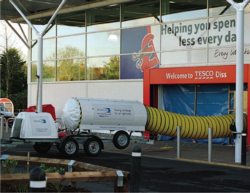Energy efficiency meets indoor air quality

Airtightness testing for new buildings is to become mandatory. If a building meets airtightness regulations, the measured ventilation rate will be accurate, and air quality can be more easily controlled.
Good indoor air quality and the efficient use of energy cannot be separated with the arrival of new Building Regulations.COLIN JUDD and DAVID BLEICHER have the details.The main thinking behind the forthcoming amendments to the Building Regulations is to reduce the energy consumption of buildings while ensuring sufficient ventilation is provided. This will improve air quality in buildings and reduce the risk of condensation forming and mould being able to grow. The new regulations are being introduced to show that good air quality does not come at an increased cost. There are currently two Part L Approved Documents: L1 for dwellings and L2 for non-dwellings. From April there will be four: L1A for new dwellings; L1B for work in existing dwellings; L2A for new non-dwellings and L2B for work in existing non-dwellings. Approved Document F will also be updated. Approved Document L is all about getting the industry to minimise the annual energy cost of a building at the design stage. Approved Document F is about ensuring healthy indoor environments by reducing the levels of pollutants and mould growth. Achieving good air quality in an office environment is an important issue. This is because the work force is a company’s biggest asset and keeping them comfortable in their work environment is beneficial to all concerned. The amendments to Approved Document F and Approved Document L of the Building Regulations have been produced to address the issues involved in achieving good indoor air quality and are expected to come into force from 6 April 2006. The System Guidance (Prescriptive Regulation) section in Approved Document F (Ventilation) covers a range of situations, so the most appropriate system can then be installed in the building. The two performance-based regulations in Approved Document F supply details of what should be done. The changes in the regulations will be an incentive for designers to produce buildings that use less energy. The new regulations apply to the building as a whole and not to individual elements separately, so everybody involved in the various design stages needs to be designing with energy efficiency in mind. Approved Document L is gives the message that energy efficiency can no longer be an afterthought. Energy consumption needs to be considered at every step. A multidisciplinary team needs to be assembled at an early stage in the design process and calculations of carbon-dioxide emissions also need to be carried out from the outset. As airtightness testing will no longer be optional, the building must be designed so that all envelope elements are specified for airtightness. This also means that the construction quality must match the designer’s specification. An overview of these two documents is as follows.
Approved Document F Approved Document F 2006 gives three ways of complying with the new regulations. 1. Specified ventilation rates. This is a performance-based method based on specified extract rates from rooms such as toilets and print rooms, and a fresh air supply rate of 10 l/s/person to office areas. The 2002 Approved Document specified a rate of 8 l/s/person, but many designers have been specifying higher fresh-air ventilation rates for some time and so complementing the new regulations. 2. System guidance. This is a prescriptive method that gives guidance for natural- and mechanical-ventilation systems. Either way, the same ventilation rates apply as for the performance-based method outlined above. Some of this guidance is contained within the Approved Document, for example on controls and locations of ventilators. Second-tier documents are relied on for further guidance, including the following. • CIBSE AM13: Mixed Mode Ventilation • CIBSE AM10: Natural Ventilation • CIBSE Guides A and B2 3. Performance criteria. This is also a performance-based regulation, as the name suggests. It details the following list of criteria that should be met. • Air supply of 10 l/s/person • No visible mould • Nitrogen-dioxide limits • Carbon-monoxide limits • Total-volatile-organic-compound (TVOC) limits • Ozone limits There is little guidance on how these criteria can be met, but all can be measured in some form. The measured levels of the pollutants listed above can be compared against the Workplace Exposure Limits (WEL) detailed in EH40 2005 produced by the HSE. These parameters are all key indicators of the air quality.
Approved Document L A brief overview of the amendments to the Approved Document L is as follows. • Dedicated Approved Documents have been produced for work in existing buildings. • Mandatory airtightness testing. • Predicting annual carbon-dioxide emissions, taking into account the measured airtightness. • Targets for carbon-dioxide emissions are 20 to 28% tighter than the 2002 Building Regulations. The measured ventilation rate into a building is only accurate if there are no holes in the external envelope of the building. If the building meets the airtightness regulations, the measured ventilation rate will be accurate, and air quality can be more easily controlled. Also, leaky buildings lose more conditioned air due to infiltration and so use more energy to maintain the internal environment. Mandatory airtightness testing will ensure that new and refurbished buildings will conform to the regulations and be more energy efficient. It is also important that the overall carbon-dioxide emissions produced in the manufacture of all the building components and the construction process are reduced to the new regulations, which are stricter than the previous regulations.
Colin Judd is a Senior Research Engineer and David Bleicher is a principal research engineer with BSRIA, Old Bracknell Lane West, Bracknell, Berks RG12 7AH.
Related links:








